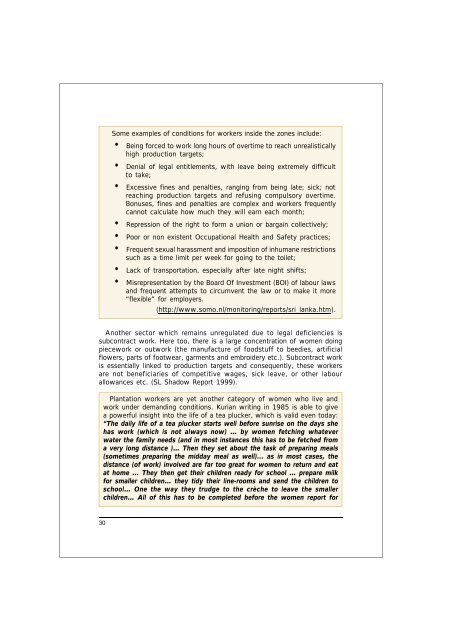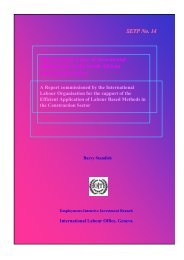Beyond Glass Ceilings and Brick Walls - International Labour ...
Beyond Glass Ceilings and Brick Walls - International Labour ...
Beyond Glass Ceilings and Brick Walls - International Labour ...
Create successful ePaper yourself
Turn your PDF publications into a flip-book with our unique Google optimized e-Paper software.
Some examples of conditions for workers inside the zones include:<br />
• Being forced to work long hours of overtime to reach unrealistically<br />
high production targets;<br />
• Denial of legal entitlements, with leave being extremely difficult<br />
to take;<br />
• Excessive fines <strong>and</strong> penalties, ranging from being late; sick; not<br />
reaching production targets <strong>and</strong> refusing compulsory overtime.<br />
Bonuses, fines <strong>and</strong> penalties are complex <strong>and</strong> workers frequently<br />
cannot calculate how much they will earn each month;<br />
• Repression of the right to form a union or bargain collectively;<br />
• Poor or non existent Occupational Health <strong>and</strong> Safety practices;<br />
• Frequent sexual harassment <strong>and</strong> imposition of inhumane restrictions<br />
such as a time limit per week for going to the toilet;<br />
• Lack of transportation, especially after late night shifts;<br />
• Misrepresentation by the Board Of Investment (BOI) of labour laws<br />
<strong>and</strong> frequent attempts to circumvent the law or to make it more<br />
“flexible” for employers.<br />
(http://www.somo.nl/monitoring/reports/sri_lanka.htm).<br />
Another sector which remains unregulated due to legal deficiencies is<br />
subcontract work. Here too, there is a large concentration of women doing<br />
piecework or outwork (the manufacture of foodstuff to beedies, artificial<br />
flowers, parts of footwear, garments <strong>and</strong> embroidery etc.). Subcontract work<br />
is essentially linked to production targets <strong>and</strong> consequently, these workers<br />
are not beneficiaries of competitive wages, sick leave, or other labour<br />
allowances etc. (SL Shadow Report 1999).<br />
Plantation workers are yet another category of women who live <strong>and</strong><br />
work under dem<strong>and</strong>ing conditions. Kurian writing in 1985 is able to give<br />
a powerful insight into the life of a tea plucker, which is valid even today:<br />
“The daily life of a tea plucker starts well before sunrise on the days she<br />
has work (which is not always now) … by women fetching whatever<br />
water the family needs (<strong>and</strong> in most instances this has to be fetched from<br />
a very long distance )… Then they set about the task of preparing meals<br />
(sometimes preparing the midday meal as well)... as in most cases, the<br />
distance (of work) involved are far too great for women to return <strong>and</strong> eat<br />
at home … They then get their children ready for school … prepare milk<br />
for smaller children… they tidy their line-rooms <strong>and</strong> send the children to<br />
school… One the way they trudge to the crèche to leave the smaller<br />
children… All of this has to be completed before the women report for<br />
30
















